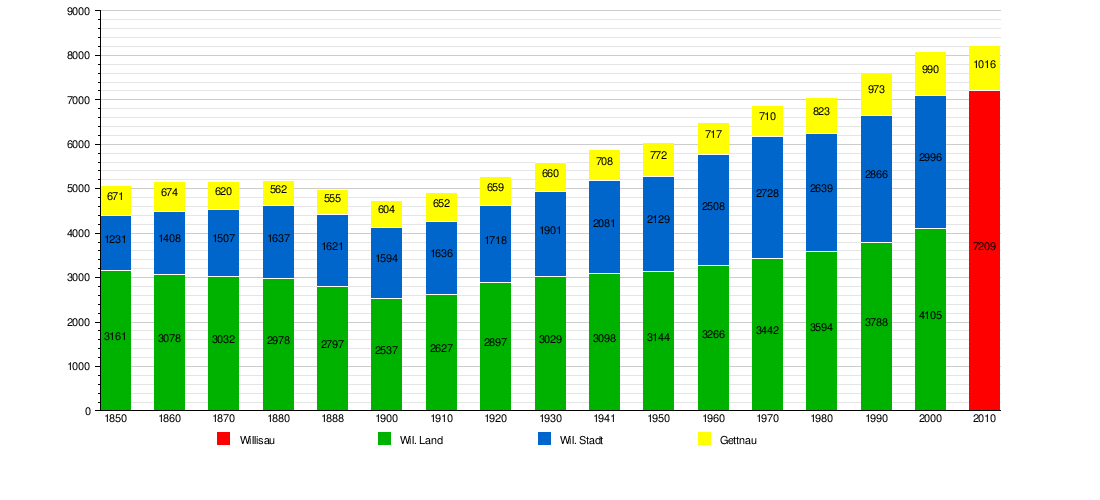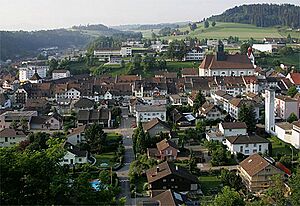Willisau facts for kids
Quick facts for kids
Willisau
|
||
|---|---|---|
 |
||
|
||
| Country | Switzerland | |
| Canton | Lucerne | |
| District | Willisau | |
| Area | ||
| • Total | 47.22 km2 (18.23 sq mi) | |
| Elevation | 557 m (1,827 ft) | |
| Population
(Dec 2020 )
|
||
| • Total | 7,752 | |
| • Density | 164.168/km2 (425.19/sq mi) | |
| Postal code |
6130
|
|
| Surrounded by | Alberswil, Ettiswil, Gettnau, Grosswangen, Hergiswil bei Willisau, Luthern, Menznau, Ufhusen, Zell | |
Willisau is a town in the Lucerne area of Switzerland. It became one big town on January 1, 2006, when two smaller towns, Willisau Land (countryside) and Willisau Stadt (city), joined together. Later, on January 1, 2021, another town called Gettnau also became part of Willisau.
Contents
History of Willisau
Willisau has a long and interesting history, going back many centuries.
Early Settlements and Town Founding
Long ago, around the 2nd or 3rd century AD, Roman people lived near where Willisau is today. Later, in 893, a settlement called Cozeriswilare or Gesserswil was mentioned. By the 11th century, there was a church in the area.
In 1302-1303, three brothers from the Hasenburg family started the fortified town of Willisau. They were allowed to build walls and defenses. The town also got the right to hold markets, which helped it grow. At first, only about 150 people lived there.
Willisau was important because it was on a trade route between Lucerne and Bern. This helped it become a key trading center.
Challenges and Survival
Willisau faced many challenges over the years. In 1375, and again in 1386 during the Sempach War, the town was burned down to stop enemies from capturing it.
In 1407, the Hasenburg family sold Willisau to Lucerne. Even after this, the town continued to grow. However, a big fire in 1471 destroyed much of the town. Over time, Willisau slowly gained more rights and became more independent.
After the Swiss peasant war of 1653, the local government leader, called a vogt, moved to Willisau. This helped the town gain more control over its own affairs. A large castle, the Bailiff's Castle, was built between 1690 and 1695 for the vogt.
By the 16th century, many craftsmen and business owners lived in Willisau. But in 1704, another fire destroyed the town for the fourth time. It took a long time for people to rebuild because many were not wealthy enough.
Willisau's Division and Reunification
For a long time, Willisau was split into two parts: Willisau Stadt (the city) and Willisau Land (the countryside). The city was generally richer, while the countryside was poorer.
In 1798, after the Helvetic Republic was created, the special rights of the city's citizens were removed. The two parts became separate towns. Even though they were separate, Willisau Stadt remained the main center for people and businesses.
By the 1990s, the two towns shared many services. On January 25, 2004, people in both towns voted to join together again. So, on January 1, 2006, Willisau Stadt and Willisau Land officially merged to form the single municipality of Willisau. Later, in 2021, Gettnau also joined Willisau.
Geography of Willisau
Willisau covers an area of about 41.69 square kilometers (16.09 square miles). A large part of this area, about 63.5%, is used for farming. Forests cover about 27.7% of the land. The rest of the land, about 8.0%, has buildings or roads, and a small part is unproductive.
Since 1981, the amount of land used for farming has decreased a bit, while the amount of forested land has slightly increased. Rivers and lakes make up a small part of the municipality's area.
People and Population
Willisau has a population of about 7,200 people. Most people in Willisau speak German as their first language (about 94.5%). Other languages spoken include Albanian and Serbo-Croatian.
About 25.4% of the population are children and teenagers (0–19 years old). Adults (20–64 years old) make up 59%, and seniors (over 64 years old) make up 15.7%.
The chart below shows how the population of Willisau and its former parts has changed over time:

Important Heritage Sites
Willisau has several important historical buildings. These include the Old City itself, the Catholic church of St. Peter and Paul, the Landvogteischloss (Bailiff's Castle), and the pilgrimage chapel of Heiligblut. These sites are considered very important to Switzerland's history and culture. The entire town of Willisau is also part of the Inventory of Swiss Heritage Sites.
Parish Church of St. Peter and Paul
The main church in Willisau, St. Peter and Paul, stands where earlier churches once were. The first church was built in the 13th century in the Romanesque style, and only its tower remains today.
The current church was built between 1805 and 1810. It has large, classic-style columns. In 1929, a modern bell tower made of reinforced concrete was added to the roof. This tower was a big achievement in building with concrete at the time. The church was restored in 1995-1997 to look like it did originally.
Holy Blood Church (Heiligblut)
The Holy Blood Chapel was built in 1674. It replaced an older Gothic chapel and an even older wooden one.
There's a famous legend about this chapel from July 7, 1392. Three men were playing cards, and one man, Ueli Schröter, lost all his money. He got angry and cursed Christ. The legend says five drops of blood fell on the table, and the Devil dragged Ueli away. The second man died trying to clean the blood, and the third ran away and died outside the town. A local priest saved the table with the five drops of "holy blood," and the first wooden chapel was built to keep it safe.
The current chapel is built in the Renaissance style with a large porch. Inside, there are three wooden altars from the early Baroque period. The walls have eight paintings that tell the story of the Holy Blood legend. The ceiling is decorated with 70 paintings by Anton Amberg, showing scenes from the Bible, the apostles, and people who supported the chapel.
Economy
Willisau is a town where both farming and industry are important. Many people work in these areas.
In 2014, almost 5,000 people worked in Willisau.
- About 486 people worked in farming businesses.
- About 1,162 people worked in manufacturing and other industries.
- About 3,240 people worked in service jobs, like shops, restaurants, and offices.
Willisau is a place where people find many different kinds of jobs. Many people use private cars to get to work, but some also use public transportation.
Education
Willisau has a good education system. Many people have finished high school, and some have gone on to higher education at universities or special colleges.
In the Canton of Lucerne, children usually attend one year of Kindergarten, followed by six years of Primary school. After that, they go to three years of lower Secondary school. Students are placed into different levels based on their abilities. After secondary school, they can continue their education or start an apprenticeship to learn a trade.
Willisau is also home to a gymnasium, which is a type of high school that prepares students for university. About 540 students attend classes there.
In the 2009–2010 school year, over 1,100 students were in school in Willisau. This included kindergarten, primary school, and secondary school students.
Willisau also has a public library called the Regionalbibliothek Willisau. In 2008, it had almost 11,000 books and other media, and people borrowed over 28,000 items that year.
Notable People from Willisau
- Moritz Anton Cappeller (1685–1769) – A scientist and doctor born in Willisau.
- Niklaus Troxler (born 1947) – A graphic designer who organized the Willisau Jazz Festival for many years.
- Urs Bühler (born 1971) – A singer and member of the famous music group Il Divo.
- Rolf Scherrer (born 1972) – A retired freestyle wrestler.
- Fabienne Meyer (born 1981) – A former bobsledder who lives in Willisau.
Images for kids
-
Catholic Church St. Peter and Paul
See also
 In Spanish: Willisau para niños
In Spanish: Willisau para niños










